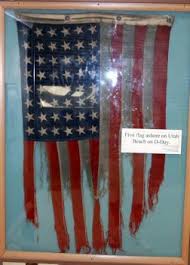Following the heroic if occasionally inaccurate The Longest Day, the next film to recount the events of June 6, 1944 was entitled The Big Red One, starring Lee Marvin and Mark Hamill. 
The film traces the experience of this unit, landing in North Africa, then Italy and finally invading northern Europe and comes close to describing events on Omaha beach. 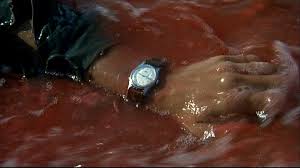
The scene that stands out to me graphically is Lee Marvin telling Mark Hamill he really did have to crawl forward under the machine guns of the Germans with a device known as a “Bangalore Torpedo” to blow a hole in the German defenses. Use of this device is the one thing in common all these films have.
What is not depicted is how lucky Mark Hamill was to have the device. On Omaha a significant amount of material was lost in the surf along with the men.
In 1994, 50 years after the event I caught a C-Span broadcast showing veterans of the landings getting up and talking about that day. 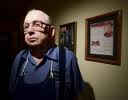
They were polite, but did not hesitate to talk about the trouble they had getting ashore, and all the death. One story sticks out in my mind. A tall handsome veteran talking about the ramp of the landing craft coming down, a solider ahead of him running into the surf, but the water was deep and he sank up to his shoulders; a wave lifted the ramp up then dropped it squarely on his head and killed him instantly. 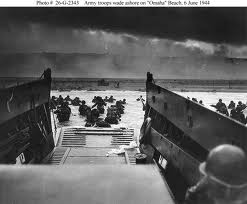
Finally by 1998, 54 years after the event, Saving Private Ryan was released followed by Band of Brothers in 2001. 
The opening scenes of Private Ryan actually happened, and mercifully spare the viewer from the recitation of speeches on the beaches the films of three decades prior seemed to require. There are no attractive and well-built women in these films providing the GI’s motivation cf Anzio. What does however need to be recognized here is the filmmaker takes some license to convey what happened. Units shown in the film did encounter much of what is shown, however events from other sectors of the beach are depicted as well all portrayed on Dog Green beach of Omaha. 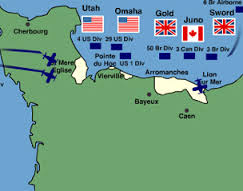
The maps generated prior to the invasion show the plan was for the Rangers, Tom Hanks unit, to land there at H-hour, on Dog Green. Actually Company A of the 116th Regiment, 29th Division landed in that place and the Rangers further west. Both units were near the Vierville draw, which the high command wanted to take right away because of the road paved on it leading off the beach. Company A assaulted the draw itself.
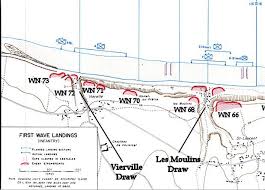
Of course the Germans knew this draw would be a likely assault path, and had a significant number of bunkers waiting for them. Historians have not been able to piece together what really happened to Company A, a group of men who had never before been in combat of any kind, but Hanks film does a good job of describing more or less what happens to exposed infantry under those conditions. 
The scene shows Tom Hanks’ boat ramp coming down, and a German gun opening up on them killing many in the craft before they were able to jump over the side. This is likely what actually happened to Company A, where 155 men went on to the beach, and in a few minutes about 100 were dead and most of the rest were wounded. 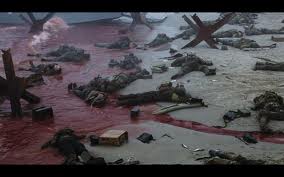
Hanks makes it to the shingle, the upslope of the beach where the bunkers that had slaughtered so many men, but at that place the Germans could not depress their weapons to fire. He tells the radio man to send a signal that Dog beach is not open, none of the tanks have made it to the beach. He tells the radio man to report this initial wave was ineffective. What this means is they were wiped out.
There is a moment where Captain Miller, played by Tom Hanks, encounters a soldier holding a typewriter taking cover behind a beach obstacle. This is meant I believe to represent the optimistic planning of high command; that the beach would be cleared easily and functions such as staff would be needed almost immediately. This was not in the German defensive plan. 
I should stop here and mention that early on in The Longest Day we do see a beach master bellowing commands at the various units arriving on the tight schedule high command decided was necessary to get the army on shore in a single day. I suspect on Sword, Juno and Gold, perhaps even Utah beach this worked out.

Not on Omaha.
After the initial waves of troops arrived ashore someone, it is not recorded who, out on the water began directing the boats to places the plans did not call for; to beaches under the bluffs, rather than to the draws where the Germans were waiting. There were still defenders on the bluffs, but not as many, and at this point Yankee initiative took over. They began climbing the bluffs the top brass presumed they couldn’t, and that is more or less how the German bunkers facing the beach were overwhelmed, from behind. 
Band of Brothers mercifully takes away from Omaha Beach to the lands behind Utah Beach on the Cotentin Peninsula.

This was no easy trip either.
The Germans had flooded the fields behind Utah Beach to frustrate glider attacks, parachutists and general advance of seaborne troops into the interior. Instead those landing on the beach would have to fight their way up narrow roads, or causeways, to achieve any kind of depth in the landing. These, like the draws on Omaha, would be heavily defended. The objective of the paratroops and glider soldiers landing further inland was to double back and seize these causeways from the rear. 
As with the rest of the landing phase of the Overlord Operation, named “Neptune”, nothing really worked out. Some gliders landed flawlessly. Some broke apart upon landing by running into the poles the Germans had driven into the earth. 
Often jeeps and other heavy equipment in the gliders broke loose and crushed the soldiers in the aircraft.
Things were not much better for the men leaping from the C-47 Dakotas. 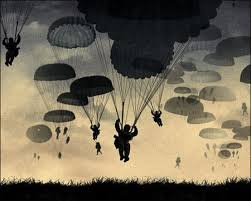
The aircraft managed to hold formation until arriving over France, where a deep cloud cover scattered the aircraft. This, combined with flying at night and heavy anti-aircraft firing from below meant when the men jumped they may, or may not be where they were supposed to be, and often only portions of units could find each other in the dark.
Like with the situation on Omaha, the Americans revised the plan to meet the primary objective, working with men from other units primarily. It took three days to secure the causeways completely. Some men were never found. Fortunately one lost group stumbled upon and shot up a German staff car carrying the commander for the Cotentin peninsula back to his headquarters early in the morning of June 6th.
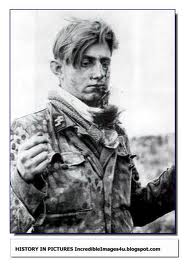
In the early movie versions of D-Day, a man getting hit has a Hollywood death. He winces, crumples and dies. 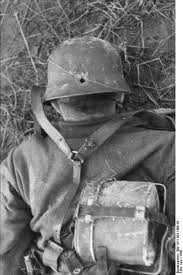
In the later movie versions there is a lot of blood, and at times we actually see the man carrying the flamethrower burst into flames himself on the beach. 
In the Veteran reports, taken usually within days of the conflict, the man with the flamethrower bursts into flame while still on the landing craft, burning those around him has he screams in his immolation, until his mess mates throw him over board to extinguish the flames, and his life.
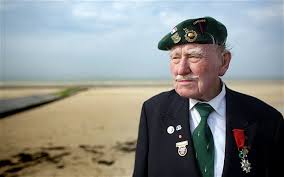
These reports have been there since the events took place. We just couldn’t look at it. The evidence is this was not an inevitable result. But for the initiative of men willing to quickly ascertain the plan wasn’t working and improvise, things could have been very different for Western Europe. 
Those men were Americans, Britons and Canadians. 